
Caltrain is a commuter rail line in California, serving the San Francisco Peninsula and Santa Clara Valley. The southern terminus is in San Jose at the Tamien station with weekday rush hour service running as far as Gilroy. The northern terminus of the line is in San Francisco at 4th and King Street. Caltrain has 28 regular stops, one limited-service weekday-only stop, one weekend and holiday-only stop (Broadway), and one football-only stop (Stanford). While average weekday ridership in 2019 exceeded 63,000, impacts of the COVID-19 pandemic have been significant: in June 2024, Caltrain had an average weekday ridership of 24,580 passengers.

Millbrae station is an intermodal transit station serving Bay Area Rapid Transit (BART) and Caltrain, located in Millbrae, California. The station is the terminal station for BART on the San Francisco Peninsula, served by two lines: The Red Line before 9 pm and the Yellow Line during the early morning and evening. It is served by all Caltrain services. The station is also served by SamTrans bus service, Commute.org and Caltrain shuttle buses, and other shuttles.
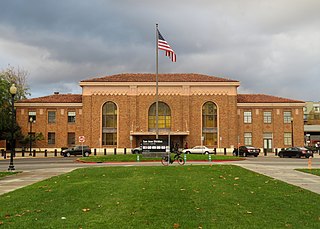
San Jose Diridon station is the central passenger rail depot for San Jose, California. It also serves as a major intermodal transit center for Santa Clara County and Silicon Valley. The station is named after former Santa Clara County Supervisor Rod Diridon Sr.
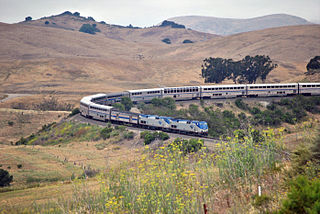
The Coast Line is a railroad line between Burbank, California and the San Francisco Bay Area, roughly along the Pacific Coast. It is the shortest rail route between Los Angeles and the Bay Area. Though not as busy as the Surf Line, the continuation of the Coast Line southbound to San Diego, it still sees freight movements and lots of passenger trains. The Pacific Surfliner, which runs from the San Diego Santa Fe Depot to San Luis Obispo via Union Station in Los Angeles, is the third busiest Amtrak route, and the busiest outside of the Northeast Corridor between Washington D.C. and Boston.

The San Francisco and San Jose Railroad (SF&SJ) was a railroad which linked the communities of San Francisco and San Jose, California, running the length of the San Francisco Peninsula. The company incorporated in 1860 and was one of the first railroads to employ Chinese laborers in its construction. It opened the first portion of its route in 1863, completing the entire 49.5-mile (80 km) route in 1864. The company was consolidated with the Southern Pacific Railroad in 1870. Today, Caltrain and the Union Pacific Railroad continue to operate trains over part of the company's original route.

Tamien station is an intermodal passenger transportation station in the Tamien neighborhood of central San Jose, California, served by the VTA light rail and the Caltrain commuter rail line, along with bus connections. The station has two elevated island platforms, one for each service. The two platforms are connected by a walkway at ground-level that is below the two platforms. The light rail platform is located in the center median of the State Route 87 freeway just north of the Alma Avenue overpass. The Caltrain platform is located just to the east, between Lick Avenue and State Route 87 and just north of Alma Avenue.

Santa Clara Transit Center is a railway station in downtown Santa Clara, California. It is served by Caltrain, Amtrak Capitol Corridor, and Altamont Corridor Express (ACE) trains. It is the planned terminus for the Silicon Valley BART extension into Santa Clara County on the future Green and Orange Lines. The former station building, constructed in 1863 by the San Francisco and San Jose Railroad, is used by the Edward Peterman Museum of Railroad History.

Palo Alto station is an intermodal transit center in Palo Alto, California. It is served by Caltrain regional rail service, SamTrans and Santa Clara VTA local bus service, Dumbarton Express regional bus service, the Stanford University Marguerite Shuttle, and several local shuttle services. Palo Alto is the second-busiest Caltrain station after San Francisco, averaging 7,764 weekday boardings by a 2018 count. The Caltrain station has two side platforms serving the two tracks of the Peninsula Subdivision and a nearby bus transfer plaza.

South San Francisco station is a Caltrain station in South San Francisco, California. The station is on the east side of the Bayshore Freeway, east and south of the curved Grand Avenue overpass, and north of where the freeway crosses over the tracks. Downtown South San Francisco is to the west, across the freeway. It previously underwent a substantial modernization and expansion project, completed in January 2022.
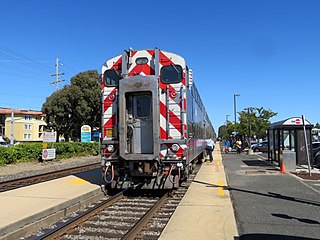
Broadway station is a Caltrain station in Burlingame, California. Caltrain only serves the stop on weekends and holidays; weekday service is provided by a bus shuttle to nearby Millbrae station.
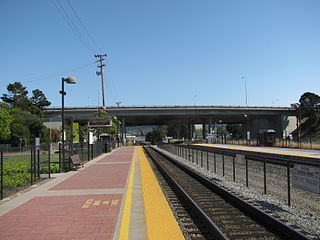
Hayward Park station is one of three Caltrain stations in San Mateo, California. It is located just to the north of the State Route 92 overcrossing, about 1,200 ft (370 m) south of the site of the original Southern Pacific station in Hayward Park. It was relocated in 1999 because of a lack of parking at the original site, and because the previous station had been sited along a curve in the tracks near 16th Avenue. The present station has two side platforms, with at-grade signalized and gate-protected pedestrian/bicycle crossings of the tracks at both its north and south ends.

Gilroy station is a Caltrain station located in Gilroy, California, United States. It is the southern terminus of the South County Connector service, and is only served during weekday rush hours in the peak direction, with trains going toward San Jose in the morning and returning southbound in the evening. The station building was constructed by the Southern Pacific Railroad in 1918 and restored in 1998. Future plans call for extended Amtrak Capitol Corridor service, as well as California High-Speed Rail trains, to also stop at Gilroy. The station was named to the National Register of Historic Places in 2019 as Gilroy Southern Pacific Railroad Depot.
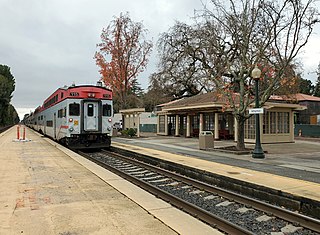
Atherton station was a Caltrain station in Atherton, California. The station had one side platform and one island platform serving the two tracks of the Peninsula Subdivision, with a concrete and wooden shelter on the west side of the tracks. The station opened by the Southern Pacific Railroad in 1866 as Fair Oaks and was renamed Atherton in 1912. Caltrain cut weekday service to the station in 2005 due to low ridership and a hold-out rule that prohibited two trains from being at the station simultaneously. Weekend and holiday service continued until December 19, 2020.

Paul Avenue station was a Caltrain station located in the Bayview neighborhood of San Francisco, California. The lightly used station was closed on August 1, 2005, and the platform and shelter were removed in 2009. A replacement station to the north has been proposed.
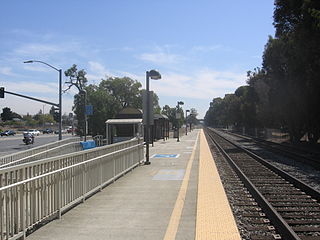
Capitol station is a Caltrain station located off Monterey Road near the Capitol Expressway, after which the station is named, in southern San Jose, California. The station is only served during weekday peak hours, with northbound trains in the morning and southbound trains in the evening. Service between San Jose and Gilroy, including Capitol station, was increased to four weekday round trips on September 25, 2023.

Blossom Hill station is a Caltrain station located off Monterey Road near the Blossom Hill Road expressway in San Jose, California. The station is only served during weekday peak hours, with northbound trains in the morning and southbound trains in the evening.
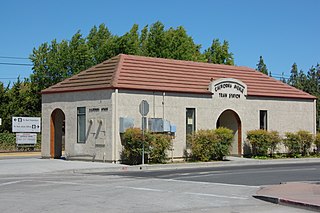
California Avenue station is a Caltrain station located in Palo Alto, California. It stops at the historical town center of Mayfield, which was annexed by the town of Palo Alto in 1925. The current station structure was built in 1983 and the station was expanded from one platform to two in 2008.

The Caltrain Express (CTX) project was implemented from 2002 to 2004 to establish the Baby Bullet express service, which shortened the transit time on the Caltrain commuter rail line between San Francisco and San Jose, and certain stations in between. New locomotives and rolling stock were purchased for dedicated express service, bypassing most stations; quad-track overtake sections were added in two locations along the Peninsula Corridor right-of-way to allow express trains to pass slower local trains that were making all stops; tracks were also upgraded with continuous-welded rail; a centralized traffic control system was added; and crossovers were added every few miles to allow single-tracking trains around disabled trains. Congresswoman Jackie Speier, then serving as a California State Senator, is credited with securing the funding for CTX and one of the new locomotives acquired for the project is named for her as a result. During commute hours, the Baby Bullet went up to 20 percent faster than driving south from San Francisco to San Jose. On September 21, 2024, with the completion of the Caltrain modernization project and the transition to electrified trains, the Baby Bullet was renamed as simply the Express service.

The Caltrain Modernization Program (CalMod), sometimes referred to as the Caltrain Electrification Project, was a $2.44 billion project which added a positive train control (PTC) system and electrified the main line of the U.S. commuter railroad Caltrain, which serves cities in the San Francisco Peninsula and Silicon Valley. The electrification included installation of a 25 kV catenary system over the double-tracked line from San Francisco to San Jose, and acquisition of new rolling stock, consisting of Stadler KISS double-decker electric multiple units (EMU). Caltrain is transitioning from its legacy push-pull trains hauled by diesel-electric locomotives, most of which have been in service since 1985.





















